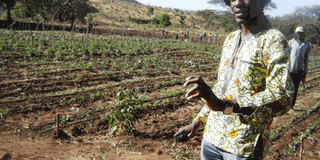Using Mt Moroto to irrigate Karamoja

WFP’s Bai Makay Sankoh explains how the programme was started. PHOTO BY STEVEN ARIONG.
Mr Paul Lorika, a 28-year-old resident of Nakambi village, Moroto district, was one of the cattle rustlers arrested by the army and tortured during the disarmament exercise. That was until he surrendered his gun back to the army officials.
After losing the gun, Lorika’s life became hard. He started burning charcoal for survival and while cutting trees one day, he was shot and injured by warriors who were still holding onto their guns.
However, that didn’t mark Mr Lorika’s end, or that of his family. When World Food Programme (WFP), cited their area (Nadiket) as the spot where to start irrigation in Moroto district, Lorika and his wife Jane Naput were the first people to embrace the project. And as he says, “I have no any interest in a gun anymore because it made me suffer. Although it had been my source of living, I have rejected it.”
Every day, he leaves his home at 7a.m. for the farm. He works from then until 6p.m. He is in charge of the main tap that waters their vegetables, which include cabbages, tomatoes, onions, eggplants, carrots and red pepper.
Ms Anna Amodoi, a mother of 12 children and also a member of Lorika’s group, says, “Though we have not yet benefitted from the programme, we have hope that these greens will now help us fight malnutrition and also improve on our house hold income because we shall be selling them.”
“If we had had this kind of support for the last three years, we would not have been disturbed by malnutrition that has killed many of our children due to a lack of balanced diet,” Amodoi says. She believes a shortage of greens in the diet of many people in Karamoja has denied them a balanced diet and has become a major cause of malnutrition. “We eat beans that WFP gives us every year because getting greens in Karamoja is very difficult since the region is dry,” she notes.
This irrigation technology, started by WFP in November last year, uses water flowing from the springs of Mt Moroto. According to the in-charge of WFP Moroto field office, Mr Bai Mankay Sankoh, the water is tapped from the rivers of Mt Moroto that flow throughout the year.
He says the technology they use diverts the water from the rivers to an underground tank of 300cubic metres. A pipe was fixed connecting to the main switch that takes water to the laid pipes where the vegetables are. “There is nothing like power that we are using for pulling water from this river to irrigate these six acres of land. It’s just connecting pipes,” he explains.
The project, costing Shs56m, was designed to show the country that although dry, Karamoja can do better with an irrigation scheme, Mr Sankoh says. He dismisses reports that the Karimojong are lazy people, saying instead that water scarcity has hindered their efforts. He believes Karamoja can do well in food production if it promotes irrigation.
Looking at Karamoja generally, the region is located in the northeastern part of Uganda and is one of the poorest and dry regions in the country with high rates of infant mortality, malnutrition, illiteracy and poverty.
The region has fertile soils but despite all that, it has endured food shortage for decades, forcing residents to largely depend on humanitarian food aid.




